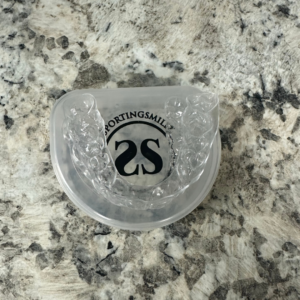
You went to put in your retainer last night only to find it didn’t look quite right. White crusty spots scattered the surface of your retainer. Yellow discoloration seems to have replaced the clear or white appearance of your clear retainer. You may also notice a less-than-appealing smell coming from your retainer too. YUCK! What does this mean? Is this stuff damaging your retainer? Could it be making you sick? Let’s look at what these changes mean, how you can avoid them, and what you can do when they strike!
Your mouth is filled with naturally occurring bacteria. Every time you eat or drink, you not only feed yourself, but you feed the bacteria as well. This is especially true of sugary sweets and drinks. When bacteria eat, they produce waste. This waste product, combined with saliva, contributes to the buildup of plaque and tartar on your teeth. When you put your retainer into your mouth, bacteria transfer onto the surface of the retainer. If it is not removed, plaque and tartar begin to accumulate on the retainer. Those white spots on your retainer are calcium deposits, or plaque, and tartar.
If your retainer is covered with calcium deposits, it may be time for a replacement retainer. Visit SportingSmiles today to learn how you can get a high-quality Essix retainer at a fraction of the cost.
In clear retainers or aligners, a buildup of bacteria-filled biofilm in your mouth covers the surface of the retainer. When left uncleaned, this film can cause a yellowish appearance. The longer it remains on your retainer, the greater the chance of it becoming hard and the stains becoming permanent.
Keeping white spots and discoloration away off your retainer begins with good oral hygiene. Brushing your teeth twice a day helps to remove food particles left behind after eating, as well as reduces the bacteria in your mouth. Brushing removes the biofilm that coats your teeth and reduces the risk of it adhering to your retainer. Flossing at night helps to remove the food particles brushing misses. If you forget to floss, those food particles become an all-night buffet for bacteria. And, given you wear your retainer at night (or at least you should be), that bacteria will use your retainer for the dance floor!
But brushing your teeth is only the beginning. You have to remember to clean your retainer at the same time. You take it out to brush your teeth, but if you don’t clean it before putting it back into your mouth, you are reintroducing bacteria and biofilm back into your mouth.
SportingSmiles offers tips and instructions for the best way to clean your retainer on our blog “How to Clean My Retainer.”
Replace your lost, cracked, gross, and damaged dental retainers with a new one from SportingSmiles. Prevent your teeth from shifting using the most durable clear retainers available. Take your own impression at home and save hundreds over going to the dentist. Impression kit included. Free Shipping in the United States. Free Storage Case 90-Day Warranty
But what happens when your retainer care routine has been lacking and the spots develop? Is your retainer ready for the trash can? The answer is maybe! You can try and remove calcium deposits and stains with a few different methods, but if they don’t come off, chances are you may need a new retainer.
If you have tried a retainer soak product, such as Fresh Guard by Efferdent, and still see white spots, crusty areas, or discoloration on your retainer, there are a couple of things you can try. They include:

Sometimes, no matter what you do, those stubborn crusty spots or stains still remain. While you may be able to live with the yellowish stains, hard white crusty spots can create a problem. As they continue to grow, they can affect how your retainer fits and can eventually cause damage to your retainer. In addition, they are a magnet for bacteria and can even make you sick. It’s important to note that with proper care, most retainers will last for 2 years before you need a replacement.
If you can’t remove the spots, your best bet is to replace your retainer. While this can be a costly expense through your orthodontist, SportingSmiles can help. Your dentist charges a high cost for a retainer because he has to make a mold of your teeth, send the mold to a lab, have them make the retainer and ship it back, and then deliver it to you. With SportingSmiles, you use our patented self-impression kit to make your own mold, ship it to our dental lab in the pre-paid package, and our technicians created the same high-quality retainer you would get from your dentist. The difference is we save you hundreds of dollars. For more information, visit Teeth Retainers today!
One Response
I need to replace my retainers.